According to the official Llandudno tourism website, Llandudno is American author Bill Bryson’s favorite seaside resort. After spending a week in this town on the North Wales coast, I can understand why so many people like to return to Llandudno for their holidays. Since the Victorian era, the town has been called the “Queen of the Welsh Resorts,” and today remains the largest seaside resort in Wales. My father and I arrived in Llandudno by way of the B5115 road, which we reached by driving along the North Wales Expressway (the A55) from England, and, after reaching the town the Victorian character of the place was striking. The first sight that really struck us was the long curved bay and all the Victorian hotels lining the seafront. To be honest, I was a little disappointed with the beach because I was expecting it to be all golden sand but it was strewn with a lot of pebbles in places, especially on areas above the high watermark. But even so, the great sweeping length of the beach was impressive and after driving a little further along the bay, we spotted the pier at the far end of the beach, near to the start of the Great Orme headland. Impressive looking buildings lined the entire length of the bay road, and between the road and the beach we noticed the wide promenade, along which people were either walking or sitting on the numerous benches that are found all along the walkway that is notable for its great width. The promenade was also built by the Victorians, in the mid-1800s. Llandudno has two beaches: North Shore along the Llandudno bay and West Shore, on the other side of the isthmus. West Shore is much less developed than the main beach (North Shore) and, at the end of our visit to the town, we found it a great place to escape to for some undisturbed reflection on what we had seen over the week that we were in the area, as well as to watch the setting of the sun. We visited West Shore on our last evening before leaving the area and witnessed an incredible sunset.
Below, I have written about some of the most impressive and enjoyable sights that we saw during our week in Llandudno. These included the Bronze Age copper mine on the Great Orme, a beautiful and unspoilt piece of land that sticks out into the Irish Sea north of the town, the trams and the cable car. The other place of particular interest to me was, of course, the pier, which I have described in a separate article. All in all, Llandudno was probably the most beautiful resort town I have ever visited. I loved the fact that the local people had obviously put so much effort into preserving the town’s unique Victorian character and atmosphere. It was a very relaxing place to be.
Llandudno cafe culture
One thing that surprised me about Llandudno was its cafe culture. The town was full of cafes, most of which were of a high quality, including good coffee, good service, and good atmosphere and decor. During our stay in the town, we visited four cafes: Cafe Nero, Cafe Culture, Cafe Orient-Express and Cafe W, the last of which was in the local Waterstones bookstore. But there were numerous other cafes that we could have visited if we had wanted to spend our whole holiday in a cafe! I have lived outside of the U.K. since 1989 and one of the things that I have really noticed over past couple of years is the vibrant cafe culture that has developed in many places in the country, and Llandudno was a perfect example of that.
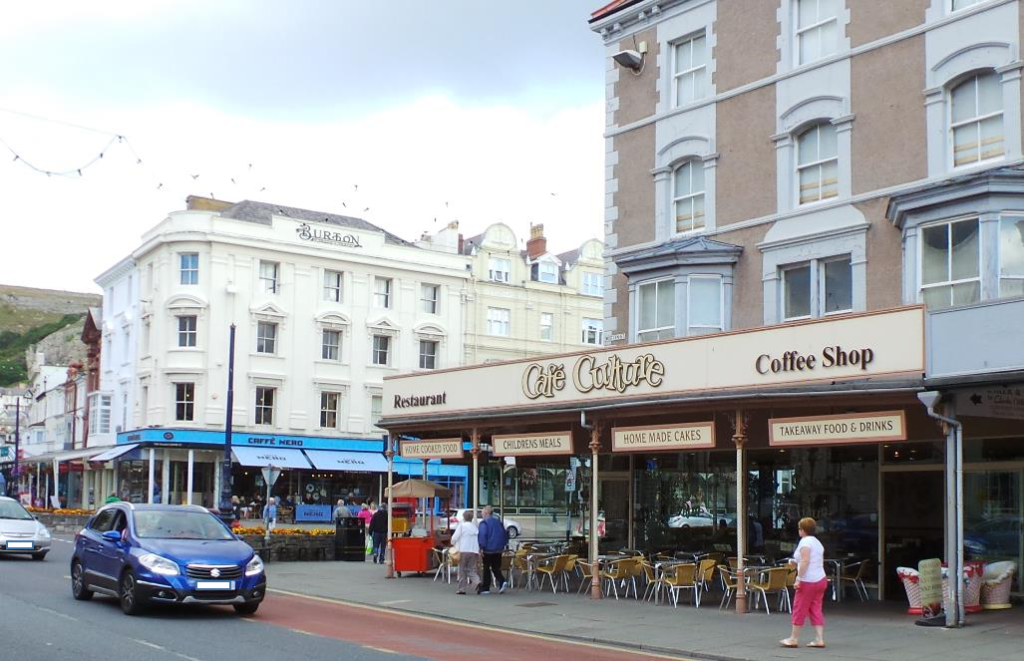
Cafe Culture and Cafe Nero (blue awning) on Mostyn Street, Llandudno. These were just two of the many cafes that I saw in Llandudno that attracted a lively number of patrons.
When I moved to Texas at the end of the 1980s, practically the only cafes around in the U.K. were roadside cafes of questionable hygiene and quality (comically called “cafs”), traditional tea rooms and cafes in department stores. Of course, you could order a coffee in a pub but you had to be pretty desperate to do that. This may be a bit of an exaggeration but I don’t think it is too far off the mark, and I am just trying to show how far the country has come in terms of its cafe culture. Now, you will see cafes all over London and other towns and cities, often with tables and chairs outside like in Paris or Amsterdam. At least as far as cafe culture goes, the U.K. has become more European, perhaps in spite of some, shall we say, distrust of European rules and regulations. I think this is one of the most visible benefits of immigration from Europe and other parts of the world where people enjoy drinking coffee and spending time in cafes as a normal part of their everyday lives. For example, I believe the Cafe Nero chain of cafes was begun by an American living in England and Cafe Orient-Express in the Llandudno town center is run by immigrants from Turkey. I enjoyed all of the cafes that we visited during our week-long sojourn in Llandudno, but I think Cafe Orient-Express was my favorite. This cafe paid homage to travel on the famed Orient Express train that takes passengers across Europe to Istanbul in Turkey. The walls of the cafe were decorated with classic travel posters used to advertise the pleasures of travel on the train.

Cafe Orient-Express at 8 Gloddaeth Street, near the town center. We visited this cafe twice during our stay in Llandudno because it was such a pleasurable place to enjoy a cappuccino and some lunch. Our waiter looked like he was serving passengers in the first-class dining car of the legendary Orient Express train.
The service in this cafe was excellent. The waiters all wore smart uniforms and were very attentive but discreet enough to let customers enjoy their meals and drinks without disturbing them. Stepping across the threshold of this establishment was like being transported back to a time when people were able to really savor their tea or coffee and enjoy some polite conversation while anticipating their arrival in Istanbul or one of the other cities along the route taken by the Orient Express. I will remember this cafe for a long time to come and I can certainly recommend it to anyone who wants to enjoy some high quality coffee and service. If you go there, make sure you are not in a hurry because you will want to take your time!
The Great Orme and the Bronze Age copper mine
The Great Orme is a huge granite headland that juts out into the Irish Sea for about two miles on the north side of Llandudno. At its widest point, it stretches for about a mile. In the Welsh language it is called Gogarth. There is a hiking trail around its periphery, so hikers can enjoy the views of towering cliffs, the sea and the surrounding country, including the mountains of the Snowdonia range. There are several attractions on the Great Orme, including a cable car that takes visitors from the Happy Valley park, across from the Grand Hotel, to the summit complex at the northern end of the Great Orme; trams that follow a track from the Great Orme Tramway station on Church Walks street in Llandudno to the terminus next to the summit complex; and an ancient copper mine now called Great Orme Mines, which dates back to the Bronze Age but which was also mined during the 19th century.
This mine is fascinating for the fact that the prehistoric chambers deep below the surface of the mine date back 3,500 years and include a huge cavern that was dug entirely by hand by Bronze Age miners. According to a little guidebook that I picked up at the visitor center at the mine, this cavern is one of the largest man-made prehistoric chambers in the world. The most amazing thing about the mine to me was that the prehistoric caverns and labyrinths were only discovered in 1987 when the local council (government) carried out an underground survey as part of preparations for redeveloping the site. Talk about hiding in plain sight! The mine was excavated and eventually opened to the public in 1991, although only a small fraction of the mine has since been fully excavated. So there are probably many more discoveries from the Bronze Age yet to come. We visited the mine and followed the self-guided tour, which included a trail along two levels of passageways that led to the large cavern mentioned above.
In places, the walls of the passageway were so narrow that we were barely able to squeeze through to continue the tour. Large people will probably have difficulty getting through some areas of the mine and it probably isn’t suitable for people who suffer from claustrophobia. The visitor center had some very informative displays that provided an overview of the history of the site and some of the discoveries that have been made by archeologists.
For more information about the copper mine, visit the official website.
Riding the old trams
At one time, Llandudno had several tramways along which trams took passengers to different destinations around the town, as well as to other towns in the area. For example, trams ran between Llandudno and Colwyn Bay, another resort town further east along the coast, during the first half of the twentieth century. The Llandudno & Colwyn Bay Electric Railway Limited began operating in 1907 and ran services to Rhos-on-Sea as well as Colwyn Bay for half a century until 1956. During our stay in Llandudno, we saw one of the remnants of this tramway close to the West Shore in the form of a round shelter that was used by tram passengers as a convenient place in which to wait for trams. It didn’t look like it is used for anything these days, except as a reminder of a bygone era. For us, it provided something else of historical and aesthetic interest to look at in addition to the coastline along West Shore and the beautiful sunset that we saw on our last evening in the town.
The Great Orme Tramway started operating in 1902. From the beginning, it was planned as a service for tourists as well as local people. The main station in Llandudno is located on Church Walks road. From here, trams take passengers to a halfway station, which was built only in 2001. From this large and rather rustic building, trams continue to the summit of the Great Orme and the tramway terminus, from which there are wonderful views of the surrounding sea and coastline leading to Conwy and the mountains of Snowdonia.
On the day that we wanted to take a tram, some maintenance work was underway and so the tram operating company provided a bus that took us from the main station in Llandudno to the halfway station, from where we transferred to a tram that took us the rest of the way to the summit. Along the way we enjoyed the views of the countryside over the Great Orme as we passed the site of the Bronze Age copper mine and headed higher to the summit. Overhead passed the cable cars, and of course we could see for miles along the coast and across the land that forms this part of North Wales.
On reaching the summit we went for a walk along a hiking trail that ran down from the summit and around the edge of the Great Orme to take in the views. There were not many people out on this trail and we pretty much had the views to ourselves. You never know who you are going to meet when taking the path less traveled and we briefly met poet Philip Wells who was walking toward us – barefoot – on the hiking trail on his way around the Great Orme and then to Anglesey. At that moment he seemed a rather quixotic and eccentric character but I later discovered that he was nearing the end of a 1000-mile walk raising money to help poor children. We exchanged a few words as we passed on the trail, but I missed my chance to ask him about what he was doing, and then he was gone. I quickly turned my attention to the view of the Snowdonia mountains that we could see from our vantage point, but after we returned to our hotel, I searched in Google and found the Barefoot Billion website. I was happy to learn a few days later that the poet had completed his journey.
After walking for about 30 minutes, the weather started to take a bad turn. The sky overhead darkened with rain clouds and so we headed back toward the summit complex, which housed a cafe and restaurant. It was raining quite violently by the time we reached the summit and we hurried inside the building and went to the restaurant, where we enjoyed a pot of tea, pasties and the most stupendous trifles I have ever tasted. Outside it had felt more like autumn than summer as the rain and wind had also brought with it some cool air. A lot of people obviously had the same idea as us about escaping from the cold and dampness because the restaurant was so crowded. After finishing our lunch, by which time the rain had ceased and the sun was shining again, we took the cable car back to Llandudno. This day reminded me just how “moody” British weather can be, especially in the summer.
The trams operate from late March until late October. For more information about the Great Orme trams, visit the official website for the tram.
The Llandudno Cable Car
The Llandudno Cable Car dates from 1969 and is the longest cable car of its kind in the U.K. The cable car carries visitors from Happy Valley, near the Grand Hotel and pier, to the summit of the Great Orme. Each cabin can accommodate about four people and provides spectacular views of Llandudno, the Great Orme and the nearby countryside of North Wales, not to mention ships passing while voyaging between Liverpool and Holyhead.
On our visit, we took the tram to the summit of the Great Orme, and later returned to Llandudno by the cable car. The cable car moved at a fairly leisurely pace and the journey from the summit probably took about 15-20 minutes. Even though we had had to stand in line for a long time (about 20 minutes) at the summit ticket office to get our tickets, the wait was well worth it. Considering we were there in August during the peak tourist season, I thought the wait was not too bad and everyone waiting in line were in good spirits.
The views from our cabin really were magnificent and I think, along with the pier, they were what I enjoyed the most during our stay in Llandudno. As we descended from the summit we passed near the site of the prehistoric copper mine and the tramway halfway station, before gliding over some rocky outcrops that looked like they were in a remote wilderness. We then spotted the pier jutting out into the sea and the artificial ski slope, and, finally, we passed over a dense stand of conifer trees before reaching the terminus building at Happy Valley. Our cable car ride came to an end much too soon. What would have made me even happier would have been for the ride to have lasted twice as long as it did!
The Llandudno Cable Car operates from April 1 until October 31. For more information about the cable car, see the official Llandudno tourist website.
For the latest tourist information about Llandudno, visit http://www.visitllandudno.org.uk/. For a more historical perspective on the town, the Old Llandudno website is very informative.
(All text and photographs copyright 2014, anothercappuccino.com.)

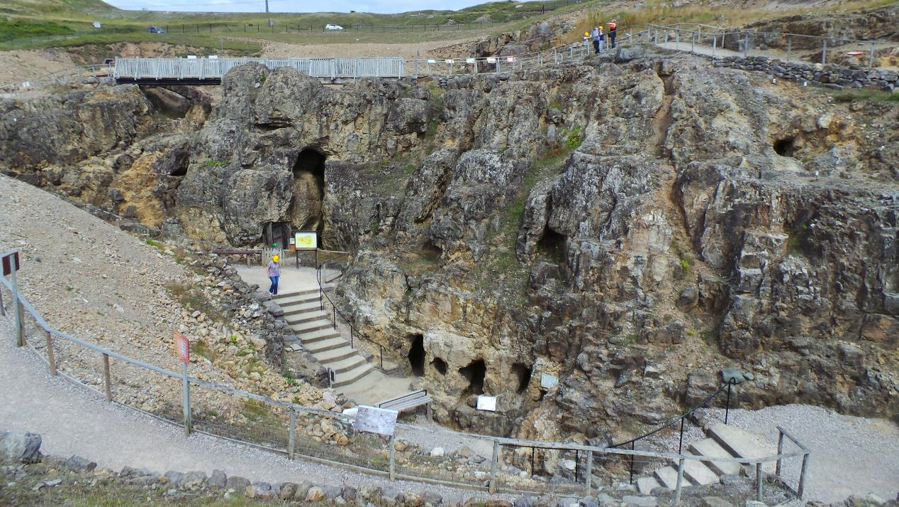
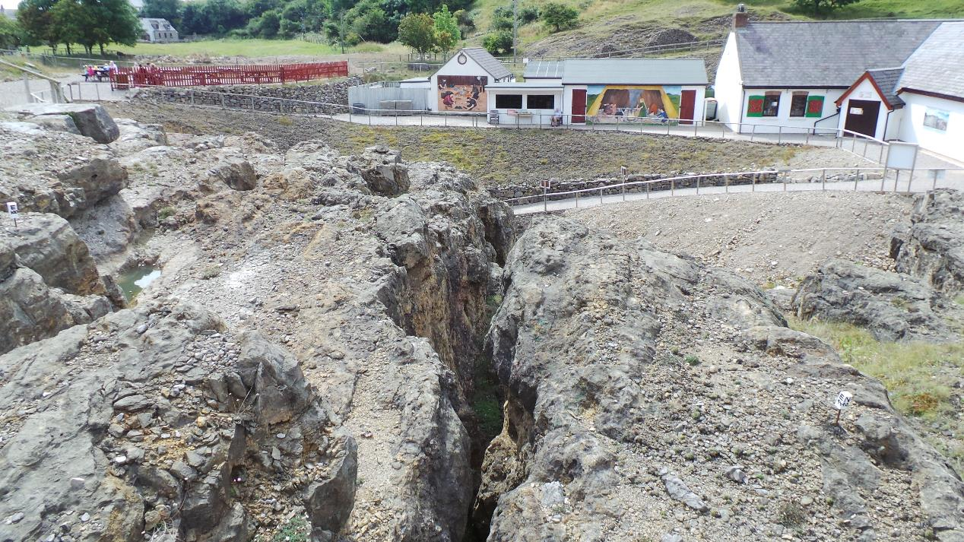
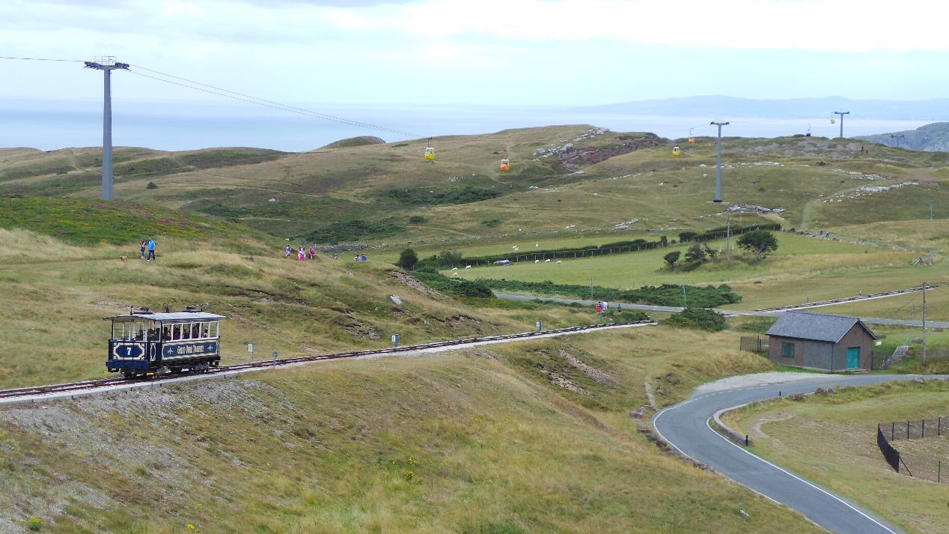

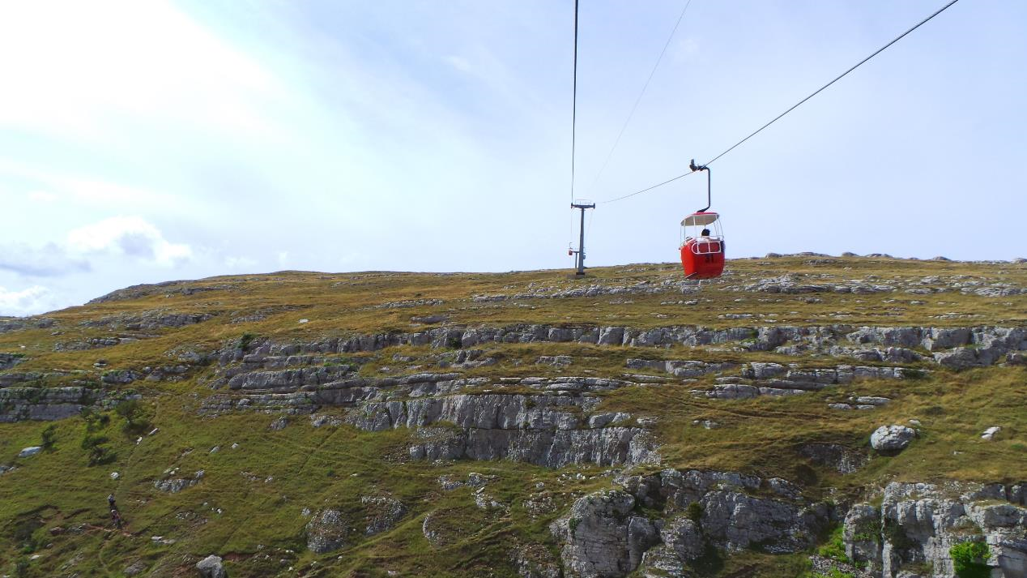
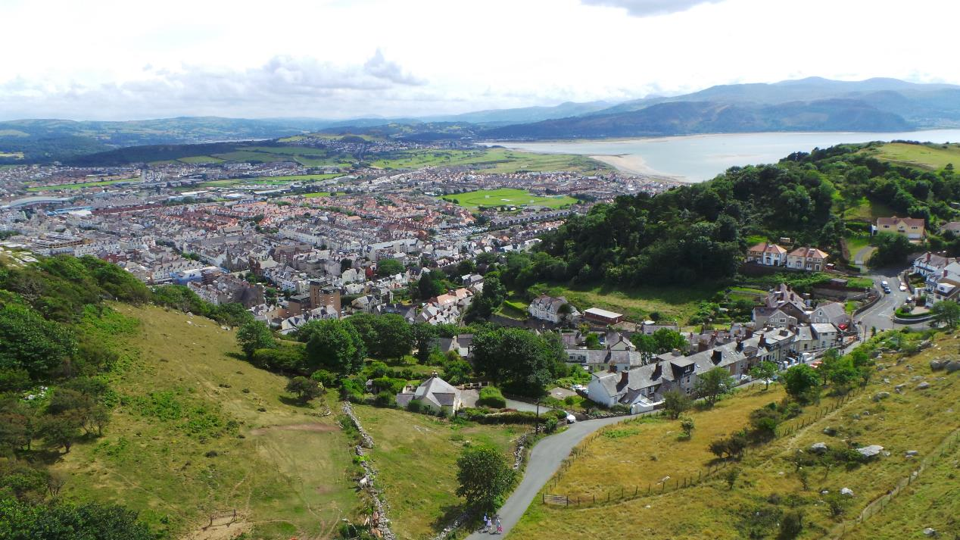

I really enjoyed reading the gentle excitement of this story.